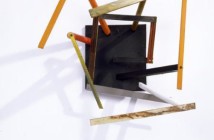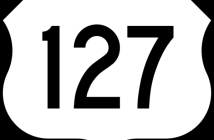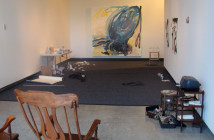Google-ing the Real is a group show of 11 artists from the School of the Museum of Fine Arts, all engaged in the “complex interaction between technology and everyday life.” For this exhibition, a so-called “everyday life” should not be accounted for without addressing the ever changing and manipulative aspects of technology that govern our present condition.
With such a tall order on hand, one might even say impossible, I remain both skeptical and encouraged at these artists attempts to tackle such potent subject matter.
Several of the videos take 9/11 and the subsequent war in Iraq as their subject, or at least obliquely conjure its presence. Lior Neiger’s projection Globe consists of two globes on a split screen, each one spinning and halting to a stop juxtaposing one location in the world with another. There seems to be no formulas for the countries juxtapositions, making the encounters seem arbitrary. Perhaps this reflects the ever pervasive indifference of many citizens towards our countries current war tactics, or coyly proposes how relationships and enemies are formed in times of war: by chance. In 15 Reasons To Go To War, Terrafarmer Collective take war as a subject head on. Images taken from the Internet were collected and then collaged, together forming an ever-changing landscape of destruction and “latent sexuality.” What is alarming about this piece is the sheer indulgence and brazenness of the images in contrast to their almost romantic movement through the digital landscape. Images of women proudly bear their breasts on one screen while planes fly through construction sites and over freeways in another. The three-screen format works well for the piece as images float from one screen to the next and disappear only to reappear in another. No image is ever fixed and remains in constant flux, never allowing the viewer to fetishize upon one particular part. However, I remain confident that Terrafarmer does not, “expose reasons…for the current contemporary landscape of American foreign policy [and]foreign perception” though they do take the historically political strategy of collage and update its aesthetic via video and digital manipulation.
Susannah Lawrence addresses what a few others in the show pick up on as well: that of the observer and the reality of surveillance and digital cataloging of human activities. In Giants, images of the exhibition participants appear to be peering in on unsuspecting viewers. In a carefully framed projection within the architecture of the space, each figure watches over the exhibition space, monitoring and scrutinizing whoever is present. In Street Light Texas/Satellite Image Baghdad, Natasha Seideneck presents a digital photograph on the wall with a similar type of image projected on the floor below it. The flickering pixilated projection is a still image taken from an Internet site that shows surveillance photos of Baghdad. The juxtaposition with a street light in Texas seems to have nothing to do with the Baghdad projection, except that each are manipulated and aesthetisized with the same type of digital filters. In this sense, all images have some relationship with each other, making the poignancy of the locale seem entirely pointless. This recalls Neiger’s Globe where the potential politic of the work is permanently suspended and couched within arbitrary concurrence. Also dealing with surveillance and monitoring is Leigh Brodie whose Surveil-dance shows a quad screen format akin to a typical security monitor. Each image has time codes running and shows a woman performing an awkward dance through the four “spaces.” Though the piece is electronically constructed she twirls herself through each space seamlessly, as if she were negotiating time and location on her own terms.
What differentiates Brodie’s work from the aforementioned artists is the insertion of herself into the “unreal” space of technology. She does not rely on indulgent collages and seductive digital manipulations to re-present the complexities of technological space, but simply does a dance in it. Likewise, in Nicole Arendt’s Uni, a figure wearing a decapitated unicorn mask attempts to jump on a trampoline in the backyard of a generalized rural setting. The video is virtuous in its editing as the figure gravitates, and does a dance of her own above the trampoline, suggesting this masked oddity is stuck forever in jump cuts and glitches. If I insist on the work of Arendt and Brody it is because they do not seem to be overly invested with the aesthetics of video and, above all, digital manipulation. Rather, their works speak poetically about one’s position within the technological landscape. They do not rest on a re-presentation of politics, as Neiger, Seideneck, and Terrafarmer, instead show how technology is a real space in itself, one that allows, and even requires constant negotiation.
Links:
Judy Rotenberg Gallery LLC
"Google-ing the Real" is on view until June 19th at Judi Rotenberg Gallery Annex, 130 Newbury St., Boston.
All images are courtesy of the artists and Judi Rotenberg Gallery LLC.
Micah J. Malone is a regular contributor to Big, Red & Shiny.




